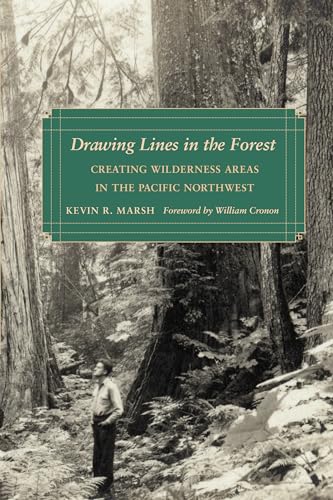Items related to Drawing Lines in the Forest: Creating Wilderness Areas...
Drawing Lines in the Forest: Creating Wilderness Areas in the Pacific Northwest (Weyerhaeuser Environmental Books) - Hardcover

Synopsis
Drawing boundaries around wilderness areas often serves a double purpose: protection of the land within the boundary and release of the land outside the boundary to resource extraction and other development. In Drawing Lines in the Forest, Kevin R. Marsh discusses the roles played by various groups―the Forest Service, the timber industry, recreationists, and environmentalists―in arriving at these boundaries. He shows that pragmatic, rather than ideological, goals were often paramount, with all sides benefiting.
After World War II, representatives of both logging and recreation use sought to draw boundaries that would serve to guarantee access to specific areas of public lands. The logging industry wanted to secure a guaranteed supply of timber, as an era of stewardship of the nation's public forests gave way to an emphasis on rapid extraction of timber resources. This spawned a grassroots preservationist movement that ultimately challenged the managerial power of the Forest Service. The Wilderness Act of 1964 provided an opportunity for groups on all sides to participate openly and effectively in the political process of defining wilderness boundaries.
The often contentious debates over the creation of wilderness areas in the Cascade Mountains in Oregon and Washington represent the most significant stages in the national history of wilderness conservation since World War II: Three Sisters, North Cascades and Glacier Peak, Mount Jefferson, Alpine Lakes, French Pete, and the state-wide wilderness acts of 1984.
"synopsis" may belong to another edition of this title.
About the Author
Kevin R. Marsh is associate professor of history at Idaho State University in Pocatello.
From the Back Cover
Drawing boundaries around wildlands serves a double purpose--both protection of the land within the boundary and release of the land outside the boundary to resource extraction and development. This book looks at the process of establishing those boundaries and the roles played by various groups--the U.S. Forest Service, timber companies, recreationists, and environmentalists.
New in Paperback--Drawing boundaries around wildlands serves a double purpose--both protection of the land within the boundary and release of the land outside the boundary to resource extraction and development. This book discusses the roles played by various groups--the U.S. Forest Service, timber companies, recreationists, and environmentalists--in defining the boundaries of wilderness areas
From the Inside Flap
Drawing boundaries around wildlands serves a double purpose--both protection of the land within the boundary and release of the land outside the boundary to resource extraction and development. This book looks at the process of establishing those boundaries and the roles played by various groups--the U.S. Forest Service, timber companies, recreationists, and environmentalists.
New in Paperback--Drawing boundaries around wildlands serves a double purpose--both protection of the land within the boundary and release of the land outside the boundary to resource extraction and development. This book discusses the roles played by various groups--the U.S. Forest Service, timber companies, recreationists, and environmentalists--in defining the boundaries of wilderness areas
"About this title" may belong to another edition of this title.
FREE shipping within U.S.A.
Destination, rates & speedsSearch results for Drawing Lines in the Forest: Creating Wilderness Areas...
Drawing Lines in the Forest: Creating Wilderness Areas in the Pacific Northwest (Weyerhaeuser Environmental Books)
Seller: Zoom Books Company, Lynden, WA, U.S.A.
Condition: good. Book is in good condition and may include underlining highlighting and minimal wear. The book can also include "From the library of" labels. May not contain miscellaneous items toys, dvds, etc. . We offer 100% money back guarantee and 24 7 customer service. Seller Inventory # ZBV.0295987022.G
Quantity: 1 available
Drawing Lines in the Forest : Creating Wilderness Areas in the Pacific Northwest
Seller: Better World Books, Mishawaka, IN, U.S.A.
Condition: Very Good. Used book that is in excellent condition. May show signs of wear or have minor defects. Seller Inventory # 15911761-6
Quantity: 1 available
Drawing Lines in the Forest: Creating Wilderness Areas in the Pacific Northwest (Weyerhaeuser Environmental Books)
Seller: Lowry's Books, Three Rivers, MI, U.S.A.
Hardcover. Condition: Very Good. Dust Jacket Condition: Very Good. This copy has no corner bumping, very little edgewear. Interior text is clean and binding tight. A very good copy. Seller Inventory # 603726
Quantity: 1 available
Drawing Lines in the Forest: Creating Wilderness Areas in the Pacific Northwest (Weyerhaeuser Environmental Books)
Seller: Walk A Crooked Mile Books, Williamsburg, PA, U.S.A.
Hardcover. Condition: Fine. Illustrated (illustrator). 1st Edition. 0295987022 NAT 037214 LOC First ed. Solid and clean hard cover like new, jacket is almost like new, we have applied a protective fold-on cover. 227pp. Seller Inventory # 037214
Quantity: 1 available
Drawing Lines in the Forest: Creating Wilderness Areas in the Pacific Northwest
Seller: N. Fagin Books, Chicago, IL, U.S.A.
Hardcover. Condition: Very Good. Dust Jacket Included. 2007. Natural History Conservation. University of Washington Press. 225p., fine cloth and very good dust jacket. 8/25. Seller Inventory # 1431491312
Quantity: 1 available
Drawing Lines in the Forest: Creating Wilderness Areas in the Pacific Northwest
Seller: Barker Books & Vintage, Helena, MT, U.S.A.
Hardcover. First edition. First printing, near fine cloth hardcover in near fine dust jacket with both showing just a hint of wear. 256 pages with maps and a set of black & white plates. Still a good looking copy of this post WW II general and political history of the Northwest wilderness. Near Fine in Near Fine Dust Jacket. Seller Inventory # 25642
Quantity: 1 available
Drawing Lines in the Forest: Creating Wilderness Areas in the Pacific Northwest (Weyerhaeuser Environmental Books)
Seller: Gold Country Books, Sacramento, CA, U.S.A.
Hardcover. Condition: New. Dust Jacket Condition: New. New, shrinkwrapped. Unmarked. // Shipped carefully packed in a sturdy box. Seller Inventory # 015018
Quantity: 1 available
Drawing Lines in the Forest: Creating Wilderness Areas in the Pacific Northwest (Weyerhaeuser Environmental Books)
Seller: Toscana Books, AUSTIN, TX, U.S.A.
Hardcover. Condition: new. Excellent Condition.Excels in customer satisfaction, prompt replies, and quality checks. Seller Inventory # Scanned0295987022
Quantity: 1 available

